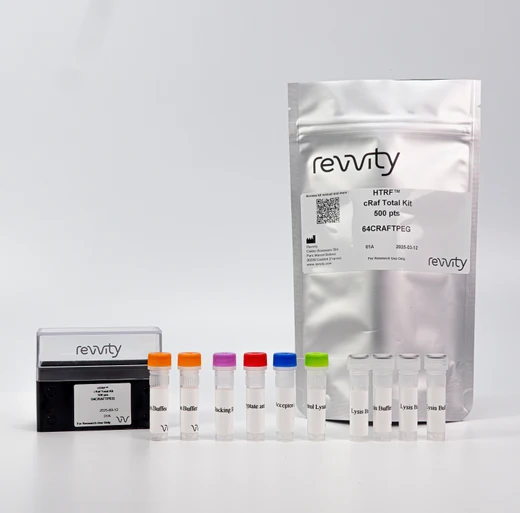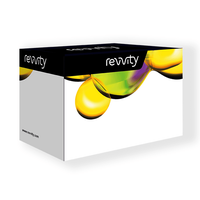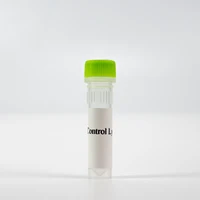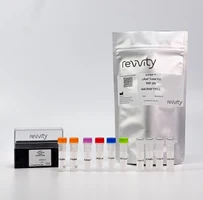

HTRF Human Total cRaf Detection Kit, 500 Assay Points






This HTRF kit enables the cell-based detection of total cRaf as a readout of the MAPK pathway.
For research use only. Not for use in diagnostic procedures. All products to be used in accordance with applicable laws and regulations including without limitation, consumption & disposal requirements under European REACH regulations (EC 1907/2006).
Product information
Overview
The Total cRaf Cellular Assay kit is designed for the robust quantification of total cRaf using a streamlined mix-and-read, no-wash protocol. cRaf plays a pivotal role in cell proliferation and differentiation. This kit can be used from basic research to high throughput drug screening. Its versatility means it is suitable for many applications, ranging from basic research to the analysis of pharmacological questions in cellular models, and has applications in oncology and infectious disease research.
Specifications
| Application |
Protein Detection
|
|---|---|
| Assay Points |
500
|
| Assay Target Type |
Kit
|
| Assay Technology |
HTRF
|
| Automation Compatible |
Yes
|
| Brand |
HTRF
|
| Detection Method |
HTRF
|
| Experimental Type |
In vitro
|
| Quantity |
1
|
| Shipping Conditions |
Shipped in Dry Ice
|
| Therapeutic Area |
Cardiovascular
Metabolism/Diabetes
Oncology & Inflammation
|
| Unit Size |
500 Assay Points
|
Video gallery


How it works
Total-cRaf assay principle
The Total cRaf assay quantifies the expression level of cRaf in a cell lysate. Unlike Western Blot, the assay is entirely plate-based and does not require gels, electrophoresis, or transfer. The Total cRaf assay uses two labeled antibodies, one coupled to a donor fluorophore and the other to an acceptor. Both antibodies are highly specific for a distinct epitope on the protein. In the presence of eNOS in a cell extract, the addition of these conjugates brings the donor fluorophore into close proximity with the acceptor and thereby generates a FRET signal. Its intensity is directly proportional to the concentration of the protein present in the sample, and provides a means of assessing the protein's expression under a no-wash assay format.

TotalcRaf two-plate assay protocol
The two-plate protocol involves culturing cells in a 96-well plate before lysis. Then lysates are transferred into a 384-well low volume detection plate before the addition of HTRF Total cRaf detection reagents. This protocol enables the cells' viability and confluence to be monitored.

Total cRaf one-plate assay protocol
Detection of Total eNOS with HTRF reagents can be performed in a single plate used for culturing, stimulation, and lysis. No washing steps are required. This HTS designed protocol enables miniaturization while maintaining robust HTRF quality.

Assay validation
Total and phospho c-RAF (S43) detection in TPA-stimulated HeLa cells
HeLa cells were plated under 100 µl in a 96-well plates (100,000 cells/well) in complete culture medium and incubated overnight at 37°C, 5% CO2. The day after, medium was removed and 50 µl of serum-free culture medium was added to starve cells for 5h at 37°C, 5% CO2. Then cells were treated with 50 µl of increasing concentrations of TPA for 15 min at 37°C, 5% CO2.
After medium removal, cells were then lysed with 50 µL of supplemented lysis buffer #2 for 30 minutes at RT under gentle shaking, and 16 µL of lysate were transferred into a low volume white microplate before the addition of 4 µL of the premixed HTRF phospho-cRaf (Ser43) or Total-cRaf detection reagents. The HTRF signal was recorded after ON incubation.

Total and phospho c-RAF (S43) detection in TPA-stimulated HEK293T cells
HEK293T cells were plated under 100 µl in a 96-well plates (100,000 cells/well) in complete culture medium and incubated overnight at 37°C, 5% CO2. The day after, medium was removed and 50 µl of serum-free culture medium was added to starve cells for 5h at 37°C, 5% CO2. Then cells were treated with 50 µl of increasing concentrations of TPA for 15 min at 37°C, 5% CO2.
After medium removal, cells were then lysed with 50 µL of supplemented lysis buffer #2 for 30 minutes at RT under gentle shaking, and 16 µL of lysate were transferred into a low volume white microplate before the addition of 4 µL of the premixed HTRF phospho-cRaf (Ser43) or Total-cRaf detection reagents. The HTRF signal was recorded after ON incubation.

Simplified pathway
Function and regulation of RSK1
RAF proto-oncogene serine/threonine-protein kinase (c-RAF) is par of the MAP kinases pathway where it links the upstream effector Ras to the downstream MAPK/ERK cascade. It therefore pays roles in cell fate decisions including proliferation, differentiation, apoptosis, survival and oncogenic transformation.
c-RAF is activated by Ser338 phosphorylation as a direct or indirect effect of PKC, or by GTP-bound Ras directly. Inactivation is ensured by the phosphorylation at Ser43 via MAPK/ERK-dependent feedback.

Resources
This guide provides you an overview of HTRF applications in several therapeutic areas.

SDS, COAs, Manuals and more
Are you looking for technical documents for this product. We have housed them in a dedicated section., click on the links below to explore.


How can we help you?
We are here to answer your questions.

































